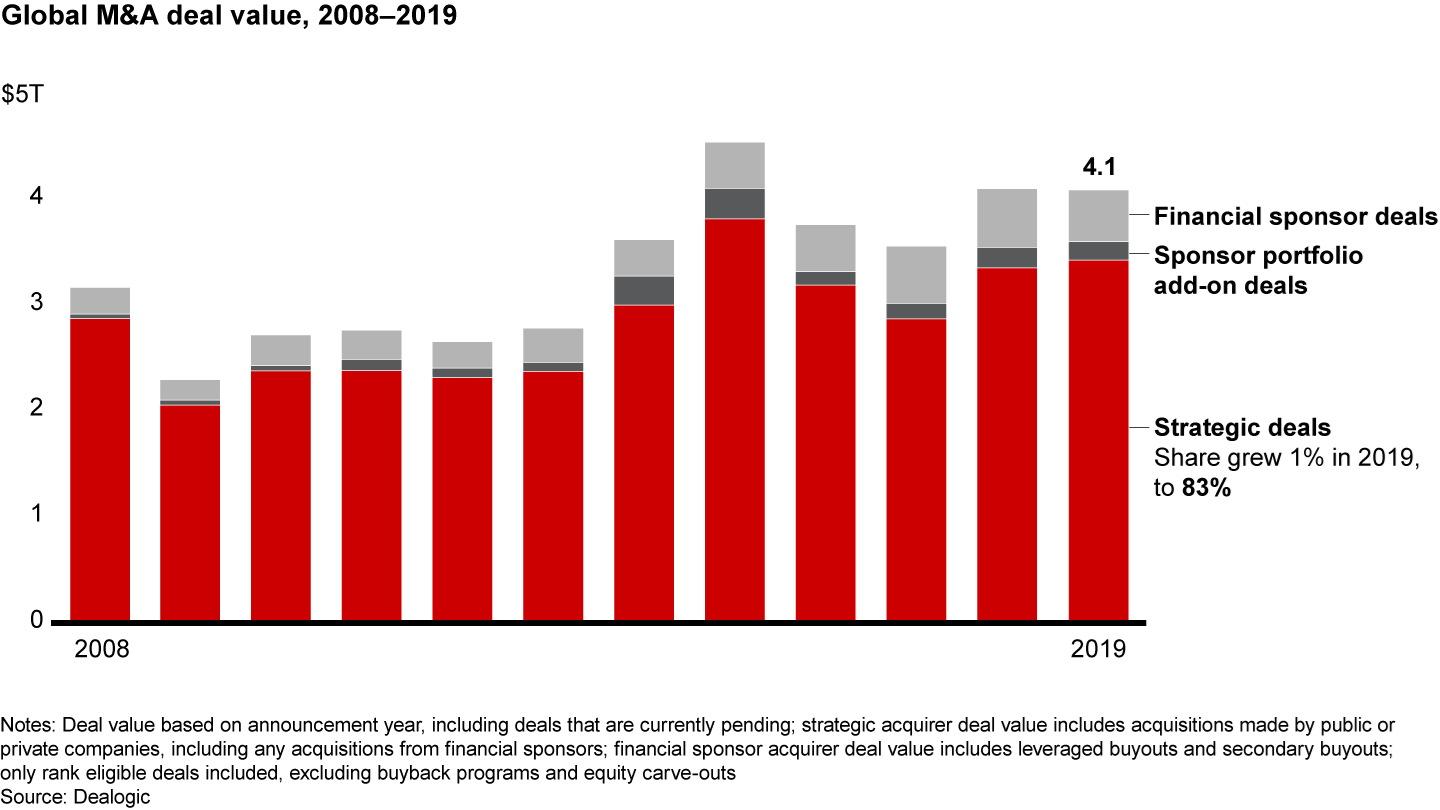Report

Резюме
- Public capital, which represents the majority of corporate M&A activity, is competing hard with private capital—and winning share, for now.
- In increasing numbers, corporations are partnering with cash-rich financial sponsors, but the union is not without complications.
- The resurgence of take-private plays by both private equity (PE) firms and activist investors provides an option for companies to pursue their transformation away from the public eye.
- For corporates, financial sponsors remain a primary source of liquidity for portfolio actions, either by selling them carve-outs or acquiring PE-owned assets.
This article is Section 2.3 of Bain's 2020 Global Corporate M&A Report. Explore our latest annual M&A report here.
Let’s be clear at the outset: 85% of all M&A is the domain of corporate acquirers—of which about 70% involves publicly listed firms (see Figure 2.5). Financial sponsors, including PE firms, account for the rest. Private equity is sitting on almost $2.5 trillion in dry powder, nearly an all-time high. These firms are highly motivated to put that money to work.
Strategic deals gained marginal share of global deal value last year


Emerging partnerships but not yet a blissful union
Cash-rich financial sponsors offer a source of capital and risk sharing for corporates. Financial sponsors generally have better transaction capabilities—finding deals, providing validation given their strong diligence capabilities, and structuring and closing deals. For their part, corporates bring strong industry knowledge and experience. The complementary offerings are fueling a steady flow of coinvestments with a variety of objectives:
- short- and long-term financial support;
- coinvestment in new technologies or emerging business models;
- partnerships to provide local anchoring in new markets;
- a path to a two-step exit for PE firms; and
- enabling a separation of operational and infrastructure assets.
As an example of financial support, consider how LEGO, through its owner Kirkbi (single-family office for the Kristiansen family), partnered with US PE firm Blackstone and the Canada Pension Plan Investment Board to acquire a majority of UK theme park operator Merlin Entertainments for $5.7 billion. This coinvestment deal will provide Merlin with the long-term investment it needs to execute on its growth plans. In another such deal, Suez partnered with CDPQ, a pension fund, to acquire GE Water for $3.4 billion in 2017.
For an example of coinvestment in new technologies, Volkswagen, BMW, Goldman Sachs Capital Partners and other investors made a $1 billion coinvestment in Northvolt, Europe’s biggest lithium-ion battery plant.
While the corporate–financial sponsor marriage makes sense on paper, these partnerships are structurally complex. It can be a worthwhile effort, as a PE partner can structure and close the deal faster for the corporate partner as well as provide validation for the investment—all while sharing the financial risk. Aligning on the objectives, sources of value creation and exit path with a PE partner, however, are better resolved before the deal is inked. It is an easier ride when the partner is a pension fund or sovereign wealth fund with similar long-term investment horizons as corporates.
Resurgence of public-to-private deals
Over the past three years, the number of publicly traded companies taken private by PE firms has sharply increased (a trend first highlighted in Bain’s Global Private Equity Report 2019). In 2018, these deals amounted to about $227 billion in value, which represents some 40% of all PE global buyout deal value (including add-on deals). The trend continued in both count and value terms in the first half of 2019. A recent example is KKR taking the $5.6 billion German digital publisher Axel Springer private. Axel Springer completed the first stage of a remarkable transformation from traditional media to digital media and intends to chart out the rest of its path as a private company.
Linked to this public-to-private trend is the rise in activist takeovers—that is, activist hedge funds acquiring control in a company or even taking it private with a full-stake acquisition. Activist capital is another form of private capital, and the activist takeover thesis accounted for around 20% of M&A activism in the year ended September 2019, an increase from about 14% in 2018, according to Activist Insight. For example, Elliott Management Corporation has aggressively pursued the activist takeover strategy and, after a protracted campaign, ended up taking the keys to bookseller Barnes & Noble in June 2019.
Most corporates’ interaction with private equity will be in portfolio management, either by selling noncore assets to a corporate sponsor or by buying new assets from them. At times, coinvestments will work favorably for both.
This article is part of Bain’s 2020 Global Corporate M&A Report. Explore the contents of the report here or download the PDF to read the full report.